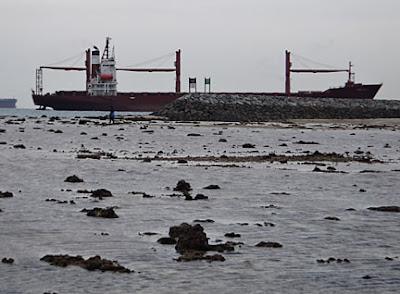This is the most 'pregnant' seahorse I've ever seen!
I was on Sisters Island to help Mei Lin and her Giant Clam Team. We also saw all kinds of corals and other marine life.
When I first saw the Tiger-tail seahorse (Hippocampus comes), I didn't even realise it was a papa. Here's some interesting facts about 'pregnant' papa seahorses....
In seahorses, it is male that carries the eggs in his body and thus becomes 'pregnant'. The female lays her eggs in his pouch using a tube that looks very much like a penis. Inside his pouch, the eggs are fertilized and become embedded into the body walls. The blood vessels in the pouch provide the eggs with oxygen and nutrients. The production of these nutrients is stimulated by prolactin, one of the hormones that affect pregnancy in mammals. Emerging from the eggs, the babies hatch as miniature seahorses and may remain in the pouch for a while before the father goes into 'labour' and ejects them out of the pouch.
The morning tides for 2012 have started! Although the spring tides are rather lame, it was low enough to get some shore work done. Today, we had FOUR teams of researchers in one boat. Two teams were heading to St. John's and Lazarus to survey the rocky shores, while Mei Lin's team broke up into two to do both Little and Big Sisters at the same time!
Kareen and I were on the team to check on the Fluted giant clam (Tridacna squamosa) at Big Sisters Island. After a little searching in the dark and high water, we found it at dawn! Wow, it's grown a lot since it was first spotted about two years ago!
Having completed our mission, we could spend the rest of trip quickly surveying the reefs there. Although it stopped raining, there was a strong wind throughout the trip. So Big Cam stayed in Dry Bag and Little Swimming Cam did all the work. Hurray, the Sargassum seaweed (Sargassum sp.) bloom is over and it was so much easier to explore the big lagoon. Compared to my last trip there in Feb 2012.
There was a splash and I managed a quick underwater shot of this octopus grappling with a swimming crab. All that can be seen of the swimming crab in the photo is its orange claw which has little blue spines.
I also came across a little Giant carpet anemone (Stichodactyla gigantea) with an anemone shrimp. There were also many Frilly sea anemones (Phymanthus sp.) as well as Carpet corallimorphs.
It was a relief to see that most of the large hard corals were not bleaching. The swimming lagoons at Sisters Islands are ringed by an artificial seawall, but the corals have crept back in!
Although the tide wasn't very low, the water was very clear today. It was like an outdoor aquarium!
As usual, most of the corals were Favid corals (Family Faviidae). There are all kinds of them on Sisters Island and most of them seemed alright. There were also many Pore corals (Porites sp.) some of them very large. I didn't see any Cauliflower corals (Pocillopora sp.) though.
There are also many other special corals on Sisters Island: Circular mushroom corals (Family Fungiidae), Carnation coral (Pectinia sp.), Crinkled sandpaper coral (Psammocora sp.), Brain anchor coral (Euphyllia ancora), Galaxy coral (Galaxea sp.), Pebble coral (Astreopora sp.), Thin disk coral (Turbinaria sp.), Ridged plate corals (Merulina sp.) and Brain corals (Family Mussidae). I didn't see but Kareen did spot Acropora corals (Acropora sp.).
I looked for and was very happy to see that the large Anemone corals (Goniopora sp.) in the lagoon were alright.
I saw four large colonies of these beautiful corals with long polyps, which often lead these hard corals to be mistaken for sea anemones. What a relief to know they are well.
I also came across several small colonies of Leathery soft corals (Family Alcyoniidae) of various kinds. As well as many different kinds of sponges.
My first time seeing the Ball sea cucumber (Phyllophorus sp.) on Sisters Island! I first noticed its feeding tentacles sticking out of the sand. Does it mean that Sisters Island is becoming sandier?
While we were exploring, huge ships passed by this tiny island. It was a relief, though, not to find any fish traps or nets in the lagoons.
We had to leave quite soon, picking up the rest of the teams on the way home. Glad to know the reefs are well and very exciting to know that there is much good work being done on our shores! Bravo to the researchers!
















